Shoulder Impingement Exercises: 11 Moves For Quick Relief
Get rid of that undue stress and strain on your shoulders with a few simple stretches.

Image: Shutterstock
Shoulder impingement is a common cause of shoulder pain (1). It is characterized by a ‘pinching’ sensation while moving the hand(s) in certain directions and may be managed using shoulder impingement exercises. Dr. Jerome G. Enad, MD and board-certified orthopedic surgeoni A healthcare professional who is trained to diagnose and treat fractures, trauma, arthritis, injuries, and spinal disorders. , says “Shoulder impingement occurs when one part of the shoulder is rubbing and grinding on another part, causing pain.”

Anti-inflammatory medications and physical therapy exercises help counteract shoulder impingement and improve hand movement. In this post, experts talk about shoulder impingement, its causes and diagnosis, and 11 exercises that can help. Scroll down!
 Workout Blueprint: Shoulder Impingement Exercises
Workout Blueprint: Shoulder Impingement Exercises- Frequency: Daily
- Benefits: Boost strength and mobility and alleviate pain.
- Equipment Needed: Towel, 1-pound dumbbell, chair, mat, therapy band.
- Space Required: Small area
- Assistance Required: Yes
- Who Should Avoid: Anyone with a history of back pain, spine problems, or other bone conditions and anyone who has recently undergone surgery.
In This Article
What Is Shoulder Impingement?
Shoulder impingement is a painful condition of the shoulder joint. It results in the physical and mechanical ‘pinching’ of a structure within the shoulder joint. Stephanie Carter Kelley, Ph.D. and a board-certified specialist in Orthopedic PT, says, “Pain typically occurs in the front aspect or deep within the shoulder as someone reaches overhead or across the body.” She explains that the main soft tissue structures pinched are:
- Rotator cuff tendons.
- Biceps tendoni Strong, flexible connective tissues that bind muscles and bones. They are essential for any kind of movement. located at the front of the joint.
- Less often, a bursa (protective fluid-filled sac) gets swollen after an injury.
A total of 464 individuals were included in a study that analyzed the prevalence of rotator cuff tendon tears and symptoms and their association with pain. The prevalence of tendon tears was 22.2%, while 8.9% had seen their general physician with shoulder pain and a rotator cuff tear, 18.8% with shoulder pain and an abnormal tendon, and 29.3% with shoulder pain.
To understand shoulder impingement and treat it, knowing what causes it is important. Scroll down for a list of factors that can cause shoulder impingement.
Key Takeaways
- Shoulder impingement causes pain as one area of the shoulder rubs and grinds against another part.
- This type of pain can stem from poor posture, muscle weakness, overactive muscles, or stiffness.
- A physical therapist can guide you through impingement exercises, such as internal rotations, wall slides, and standing rows.
What Causes Shoulder Impingement?
- Spatial Issue: Mechanical narrowing of the space above the ball-and-socket joint is a common cause of shoulder impingement (1).
- Poor Posture: Rounded upper back, shoulder blades positioned forward and tipped downward, and upper arm rotated inward.
- Stiffness: Loss of motion at any of the joints along the chain of the shoulders. Dr. Jordan Duncan, DC, says, “Decreased mobility of the thoracic spinei The middle section of the spine that starts at the base of the neck and ends at the bottom of the ribs. can also cause shoulder impingement.”
- Shoulder Instability: Injury typically causes abnormal motion of the shoulder.
- Muscle Weakness: Weakness in muscles that support and move the shoulder blade and rotator cuff muscles (group of four muscles that enable shoulder and hand movements).
- Overactive Muscles: The upper trapeziusi Broad, triangular, and thin muscles that cover the upper back of the shoulders, neck and trunk. muscles can become overactive when a person is triggered into “fight or flight” by stress or fear. These muscles run along the sides of the neck out to the top of the shoulders. According to Stephanie Carter Kelley, Ph.D., “Tension you feel all day along the sides of your neck and chronic low-level stress causes shoulders to creep up to your ears by way of upper trapezius activity. When the upper traps are overactive, they ‘take over’ the movement of reaching overhead and don’t allow the supportive muscles to properly coordinate the complex movements.”
- Repetitive Moments: Regularly performing overhead motions like swimming, painting, throwing, or even certain gym exercises may gradually lead to shoulder impingement. This is because these activities put consistent strain on the shoulder joint, increasing the risk of inflammation and discomfort over time. To help prevent this, focus on proper form and take frequent breaks to allow the shoulder to rest.
An early diagnosis is key to preventing further damage to your shoulder, as it ensures timely treatment, often involving physical therapy and lifestyle changes. Your doctor will run a few tests to confirm shoulder impingement. Find out which tests are required in the section below.
How To Diagnose Shoulder Impingement
, MD, says, “An evaluation by a shoulder specialist, sports medicine specialist, or a physical therapist is usually needed to accurately diagnose the occurrence and type of impingement. The diagnosis can typically be made with a hands-on evaluation and X-rays. Sometimes, an MRI is needed, but not always.”
Dr. Robert W. Berghorn, Jr., DPT, ATC, USAW, explains the diagnosis process. He says, “I take my patients through a detailed question and answer portion first. From there, we find out what activities or movements bother the shoulder. Next, we go into a very detailed physical exam that includes motion testing, strength testing, and special tests.”
The two tests that doctors perform are (2):
- HK Test: Using a table to stabilize the elbow, passively (i.e., using the other arm to move the symptomatic side) twist your forearm down to touch the table. Does this cause pain? How far can you let your forearm drop from the table before you have pain?
- Neer’s Impingement Sign: Have a friend gently press down on your symptomatic shoulder. Reach your arm straight in front of you, turning your thumb down like you are dumping out the contents from a soda can. Keeping that orientation of your hand, try lifting your arm over your head. If you experience pain in the shoulder, you may have shoulder impingement.
Depending on the severity of the pain and the condition, doctors may recommend anti-inflammatoryi The property of a drug that helps reduce inflammation in the body as well as redness and pain. medications and exercise therapy (under the supervision of a licensed physical therapist). The following section lists 11 exercises to rehabilitate the shoulder impingement syndrome. Take a look!
11 Shoulder Impingement Exercises To Reduce Pain
Shoulder exercises are designed to improve the strength and flexibility of your shoulders while aiding recovery from impingement. They can help reduce pain and increase shoulder mobility. However, they are not to be overdone so as to strain the shoulders any further. For any muscle-strengthening exercise, the key is to focus on form and remain comfortable while performing it. One pro tip is to apply a hot water bag to prep the muscles before starting the exercises.
Start with fewer reps and increase them gradually. You can even add weights. Apply an ice pack after you complete the exercises.
Dr. Jerome G. Enad, MD, advises “one should not ‘push through’ any fatigue or pain in the shoulder.” Let your physical therapist know if you experience pain and discomfort while exercising. With these points in mind, let’s begin with the shoulder impingement exercises.
1. Wall Slides
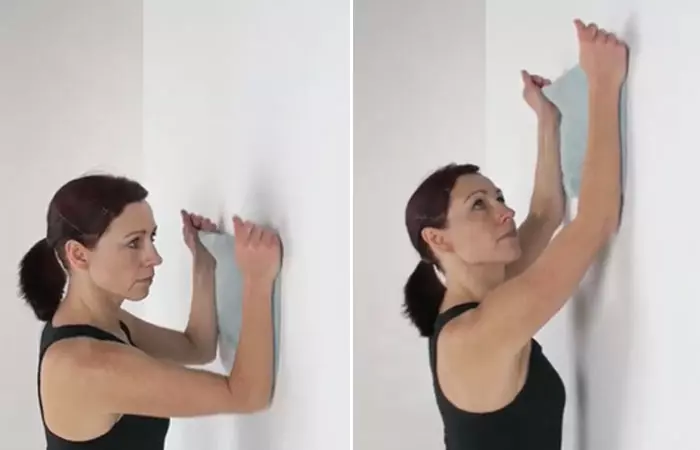
Steps
- Stand facing a wall. Hold the edges (top) of a towel with each hand.
- Place a foot closer to the wall so that you are in a staggered position.
- Place your hands on the wall while you are still holding the towel.
- Slide your hands up as far as you can.
- Pause for a moment and return to the starting position.
- Do this scapular stabilization exercise 10 times twice or thrice a day.
 Quick Tip
Quick Tip2. Shoulder Scaption
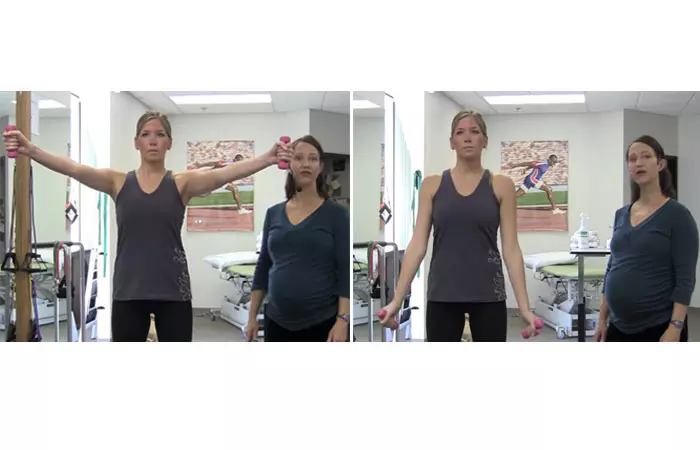
Steps
- Stand straight in front of a mirror. Hold a 1-pound dumbbell in each hand for this rotator cuff exercise.
- Raise your hands in front of you in a ‘V’. This is the starting position.
- Lower your arms slowly.
- Raise your arms again.
- Do this shoulder mobility exercise 10-12 times twice a day.
3. Posterior Capsular Stretch
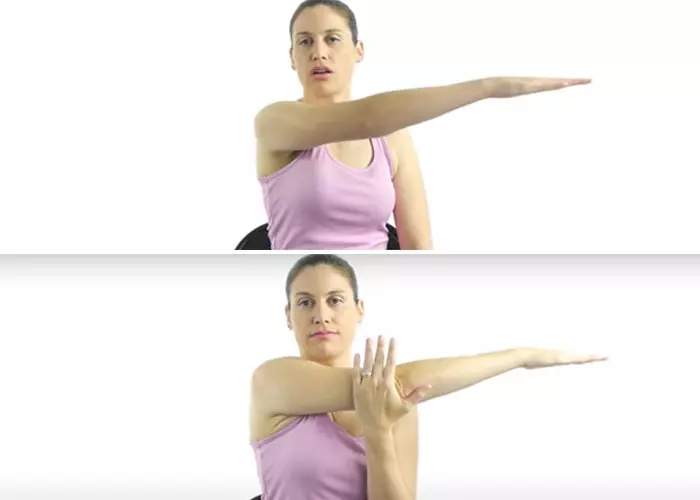
Steps
- Sit on a chair and extend your affected arm in front of you.
- Bring the arm across your body.
- With the other hand, push the affected arm’s elbow further over.
- Count to 5 and relax.
- Do this shoulder rehabilitation exercise 5-10 times twice a day.
4. Side-Lying External Rotation
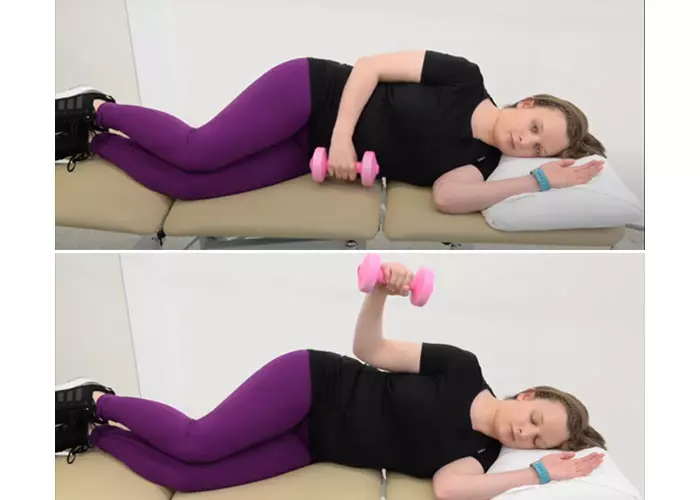
Steps
- Lie down on the unaffected side.
- Hold a 1-pound dumbbell with the other arm. Keep your elbow close to your body, and the upper arm perpendicular to the forearm.
- Move your arm up while keeping your elbow against your body.
- Pause for a moment and bring your arm back to its original position.
- Do this 10 times, two to three times a day.
Note:
If holding a 1-pound weight causes discomfort, do this shoulder strengthening exercise without weights for a while. Instead of a dumbbell, you can also use low-resistance therapy bands. This is a great rotator cuff exercise that reduces shoulder pain and increases your mobility.
5. Internal Rotation

Steps
- Secure a resistance therapy band on a door handlebar.
- Sit on a chair.
- Hold the end of the band with your affected arm. Keep your elbow close to the body and place a rolled towel in between. Your upper arm and forearm should be perpendicular to each other. This is the starting position.
- Now, pull the resistance band towards your chest.
- Pause for a moment and relax.
- Do this shoulder injury prevention exercise 10-15 times, twice a day.
Note:
It is also an ideal shoulder labral tear exercise. It relieves the pain gradually.
6. Levator Scapulae Stretch

Steps
- Sit on a chair and place your hand behind your shoulders.
- Turn your head towards the opposite direction at about 45 degrees.
- Place the other hand behind your head and lower your head.
- Pause for 5 seconds, feel the stretch, and release.
- Do this shoulder blade exercise five times on each side two or three times a day.
 Quick Tip
Quick Tip7. Open Books
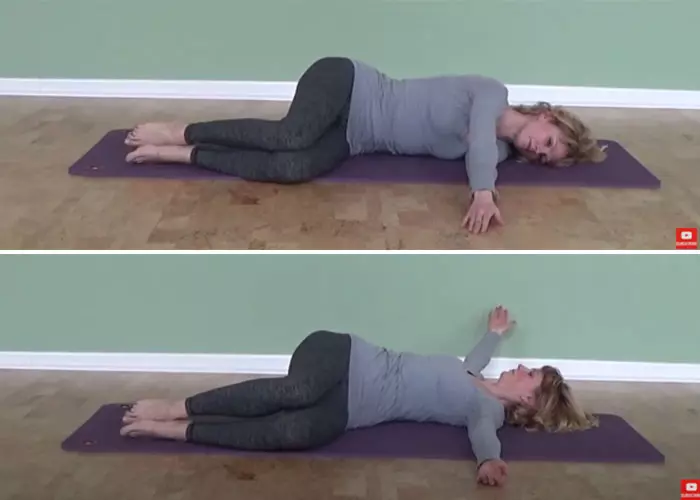
Steps
- Lie down on your side with your knees at 90 degrees and both arms in front of you.
- Lift the top arm and rotate onto the opposite side without moving your lower torso.
- Keep looking at your hand and feel the stretch.
- Pause for three seconds and come back to the original position.
- Do this shoulder joint exercise 5 times on each side twice a day.
8. Standing Rows

Steps
- Secure a therapy band on a door handle.
- Hold the ends with your hands, keep your elbows bent and close to the body, and forearms at 90 degrees.
- Pull the bands backward, squeezing your shoulder blades together.
- Count to 3 and relax.
- Do this 10 times twice a day.
9. Pectoral Stretch
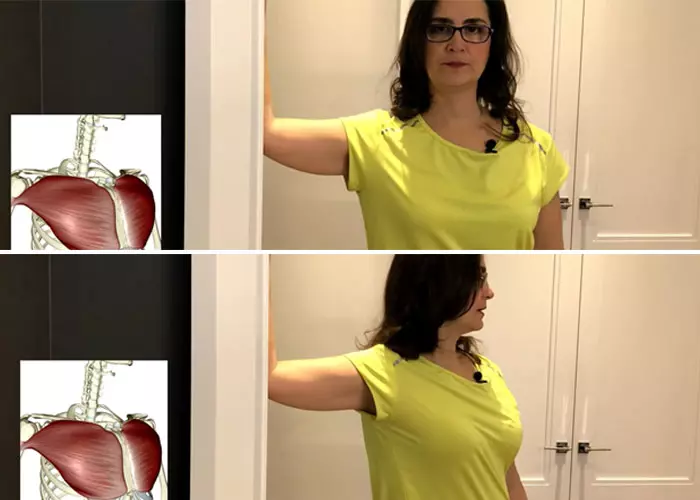
Steps
- Find a doorway and place the affected arm’s elbow against it. Your upper arms should be in line with your shoulders.
- Turn to the opposite side and feel the stretch on your upper and mid-chest, starting from the shoulder region.
- Count to 5 and relax.
- Do this 10 times twice a day.
Note:
Don’t do this stretch if it hurts.
10. Shoulder W
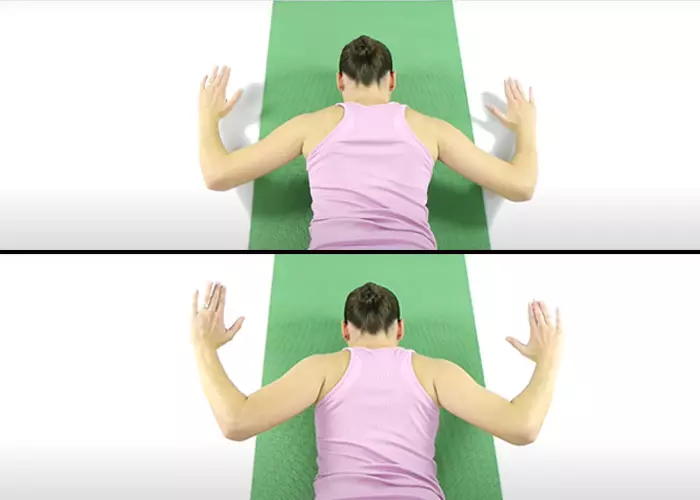
Steps
- Lie down on your belly. Position your arms such that the upper arm is in line with your shoulders and forearms are perpendicular to the upper arms.
- Lift both your arms off the floor.
- Pause for a second and relax.
- Do this shoulder pain relief exercise 10-15 times.
11. Thoracic Extension Stretch
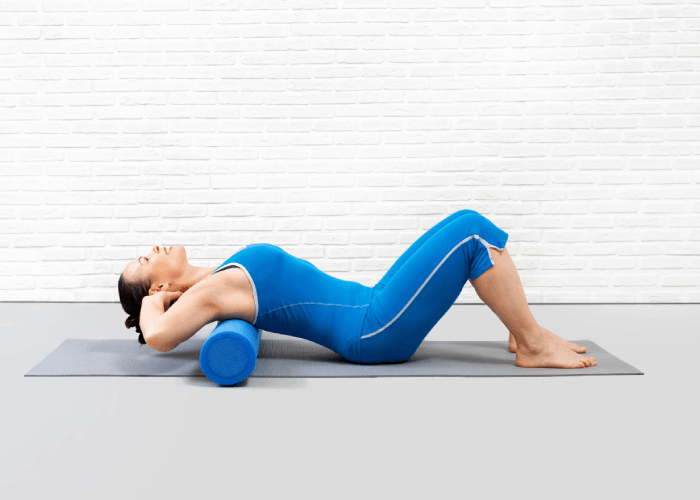
Steps
- Place a firm foam roller horizontally behind you and sit on the floor or exercise mat.
- Lean back and position the roller at your thoracic spine.
- Support your head with your hands as you interlock your fingers and place them behind your head. Do not pull on your neck.
- Lift your hips and gently roll back and forth on the foam roller.
- Start rolling from your mid-back down to the lower part of your thoracic spine and then back up.
- Pause and apply gentle pressure on any tight or sore spots for 20–30 seconds.
- Focus on your breathing. Inhale deeply through your nose and exhale slowly through your mouth.
These are the 11 exercises you can do to relieve pain due to shoulder impingement. There are also some precautions you need to take while performing them. Check them out in the section below.
Precautions For Shoulder Impingement Exercises
Here are some precautionary measures you need to take when performing shoulder impingement exercises:
- Always consult a physical therapist or healthcare provider before starting any exercise routine.
- Begin each session with a gentle warm-up to prevent injuries.
- If you experience sharp or intense pain while doing any exercise, stop doing it immediately and visit your physical therapist.
- Maintain proper posture and alignment during exercises for the best results.
- Start slow and increase the intensity of your workouts as you build strength. This will prevent your shoulder from worsening.
- Take rest days to give your shoulder time to rest and recover between sessions.
It is best to do shoulder impingement exercises after consulting an orthopedic doctor and under the supervision of a licensed physical therapist. Keep reading to learn more.
What Kind Of Physical Therapist Can Help?
Board-certified orthopedic surgeon Dr. Jerome G. Enad, MD, advises that contacting a physical therapist experienced in shoulder and joint mobilizations can help treat shoulder impingement. Stephanie Carter Kelley, Ph.D. and a board-certified specialist in orthopedic physical therapy, recommends a physical therapist certified in orthopedics or sports. Upon examining the pain history and movements, they will provide therapeutic exercises you can perform in the clinic or at home.
Diane Harper, a swimmer and a blogger, shares her experience of going through shoulder pain and how she overcame it. She was initially apprehensive about the mobility exercises. However, she says, “I’m learning the importance of doing all the exercises I am given, so I can go from sad little Karen Gorney arms to a full John Travolta stretch (i).”
Learn the best way to exercise to help relieve shoulder impingement syndrome. Watch this informative video for tips on the best exercises and how to do them correctly.
Shoulder impingement can be extremely painful and lead to restricted hand movement. Once this condition is diagnosed, your doctor may prescribe certain anti-inflammatory medications and ask you to do the shoulder impingement exercises listed above. These exercises can be done at home as you need little or no equipment. However, it is best to do these exercises under the supervision of a certified physiotherapist experienced in joint and shoulder mobilization to avoid worsening the condition or pain. Also, don’t do them hastily for quick results as it may take at least 4-6 weeks to see positive results.
Frequently Asked Questions
How can I prevent shoulder impingement in the future?
You can prevent shoulder impingement in the future by following simple tips like avoiding the overuse of your shoulder and maintaining a good posture. It is also a good idea to add shoulder-strengthening exercises like external rotations to your workout routine.
When should I see a doctor for shoulder pain?
It is best to see a doctor for shoulder pain if it lasts more than 2-3 weeks or is accompanied by symptoms like swelling and redness. It is also recommended to visit a doctor if you have trouble moving your shoulder.
How long does it take for shoulder impingement to heal?
Generally shoulder impingement heals within 3 to 6 months, with the possibility of return to regular activities within 2 to 4 weeks. However, severe shoulder impingement may take years to heal fully.
What does an impinged shoulder feel like?
Individuals with an Impinged shoulder may feel stiffness, swelling, and a throbbing sensation. Other symptoms of the condition include pain and decreased range of motion that affects daily activities.
Is massage good for shoulder impingement?
Yes, massage therapy may facilitate shoulder impingement healing and reduce pain and inflammation associated with the condition.
Which exercise to avoid during shoulder pain?
Weightlifting, swimming, and throwing weights or balls should be avoided during shoulder pain.
Personal Experience: Source
StyleCraze's articles are interwoven with authentic personal narratives that provide depth and resonance to our content. Below are the sources of the personal accounts referenced in this article.
i. Building Strength in My Shoulders and Back – What?https://fitisafeministissue.com/2025/10/12/building-strength-in-my-shoulders-and-back-what/
References
Articles on StyleCraze are backed by verified information from peer-reviewed and academic research papers, reputed organizations, research institutions, and medical associations to ensure accuracy and relevance. Read our editorial policy to learn more.
- Impingement Syndrome of the Shoulder
https://www.ncbi.nlm.nih.gov/pmc/articles/PMC5729225/ - Comparison of Manual Therapy Techniques with Therapeutic Exercise in the Treatment of Shoulder Impingement: A Randomized Controlled Pilot Clinical Trial
https://www.ncbi.nlm.nih.gov/pmc/articles/PMC2716147/
Read full bio of Alex Crockford
Read full bio of Ravi Teja Tadimalla
Read full bio of Himanshi Mahajan










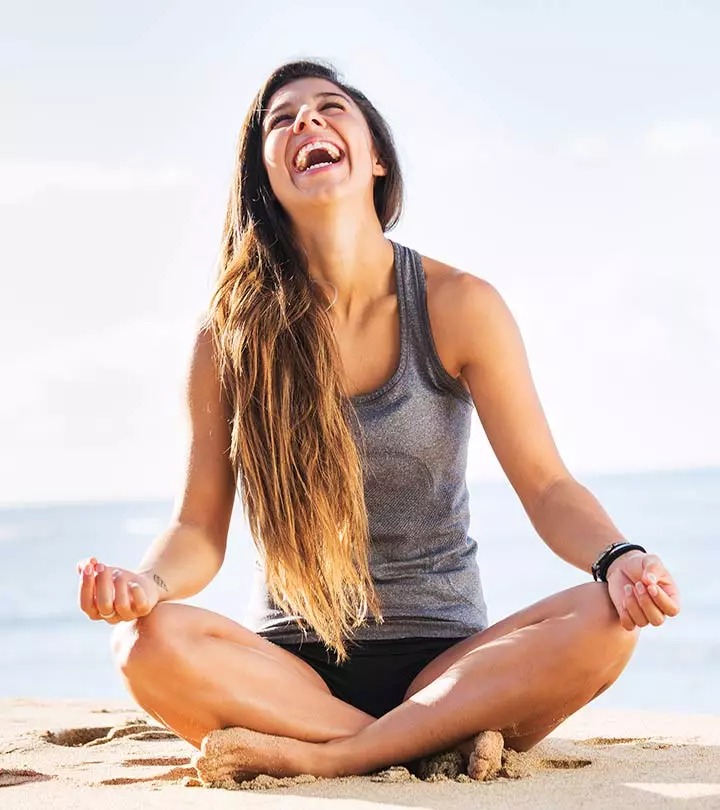






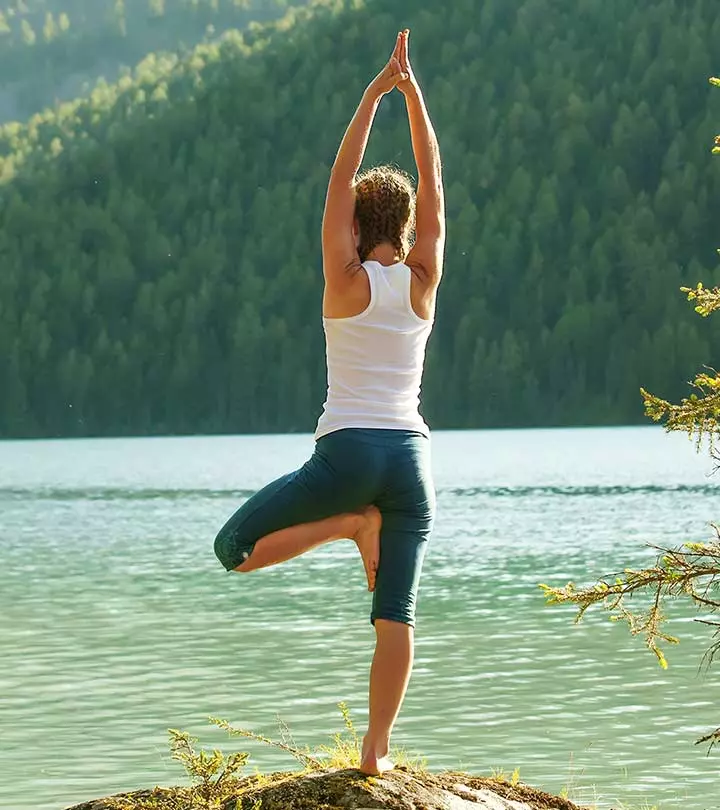

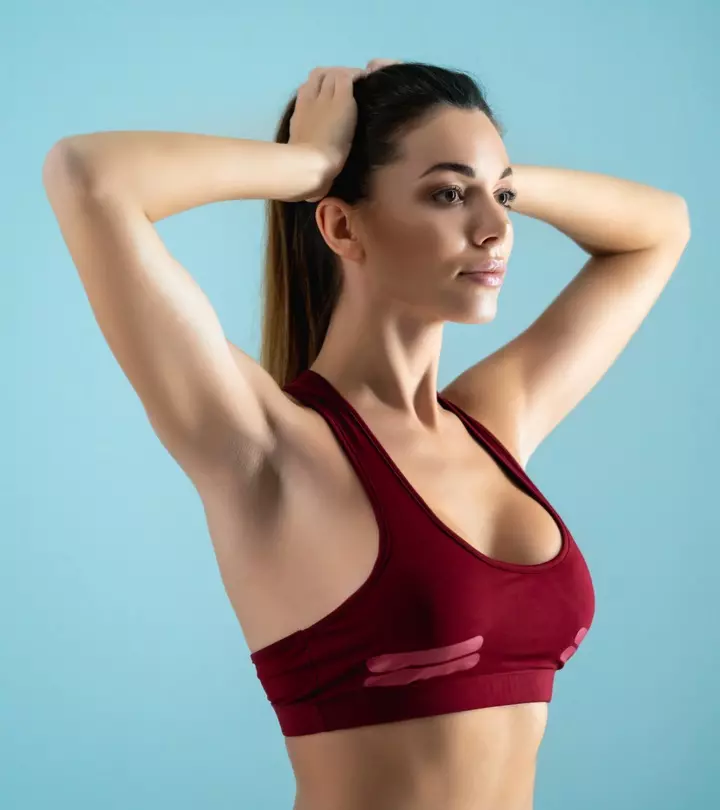







Community Experiences
Join the conversation and become a part of our empowering community! Share your stories, experiences, and insights to connect with other beauty, lifestyle, and health enthusiasts.